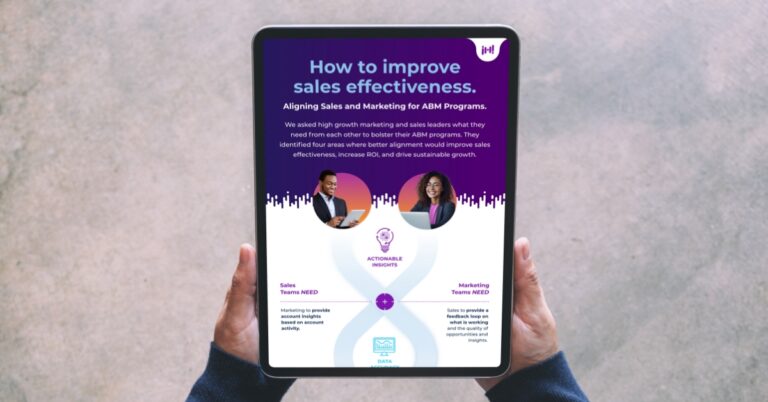Most marketing leaders know that data accuracy is important for account based marketing (ABM).
For example, in our recent survey to understand the impact of an aligned ABM approach on sales effectiveness, 58% of high growth marketers indicated that they need Sales to regularly update accurate account and contact data in the CRM.
And more than half of our respondents (51% of Sales and 52% of Marketing) highlighted a dependency on data accuracy among the top five drawbacks to their ABM approach.
Inaccurate data can affect multiple aspects of a company’s operations and performance in ways that are not immediately apparent. These costs may not be directly visible in a company’s reporting, and may manifest over time.
The costs of inaccurate ABM data.
Mismatched account targeting. Inaccurate data can lead to Marketing and Sales targeting the wrong accounts, which results in inefficiencies, and requires manual work to remediate and fix the data.
Decreased revenue. By not accurately identifying and targeting the most valuable accounts, Marketing and Sales miss out on significant revenue opportunities—and the loss of this potential revenue is hard to quantify.
Damage to reputation and trust. Inaccurate data can lead to Marketing and Sales sending irrelevant or incorrect information to prospects and customers, which leads to lower engagement rates, reduced conversion rates, and a lower ROI, ultimately damaging a company’s reputation and eroding customer trust.
Sales team frustration and reduced productivity. Sales teams rely on accurate data to effectively prioritize and engage with leads. Inaccurate data can lead to sales reps spending their time chasing unqualified leads or encountering incorrect contact information, which can result in a gradual, subtle decline in productivity.
Higher customer acquisition costs. When targeting the wrong accounts, the cost of acquiring new customers can increase. This hidden cost manifests as a higher average cost per acquisition over time, as more resources are required to achieve the same results.
For senior marketing and sales leaders, aligning around data accuracy isn’t just a best practice—it’s a necessity for improving sales effectiveness.
So, let’s talk about how you can ensure your teams are on the same page when it comes to data.
Prioritizing ABM data accuracy.
Making data accuracy a priority requires a concerted effort from both Marketing and Sales.
To ensure that your marketing and sales teams are aligned and operating at maximum efficiency, it’s imperative to regularly audit and cleanse your database. However, not all data is created equal.
Here’s a step-by-step approach to implementing this strategy effectively:
- Identify key data fields. Some data fields are more critical than others. By identifying the most important data fields, such as industry, revenue, and contact information, you ensure that your efforts are focused on the information that will have the most significant impact versus all of the fields that are in your marketing and sales systems.
- Target high-priority accounts. Some accounts are more valuable to your business than others. This means that when thinking about data accuracy, target your efforts on high-priority accounts, such as existing customers and accounts on your target account list. With unlimited time and budget, you’d treat all your accounts this way, but in the real world, you need to establish some priorities.
- Schedule regular data cleansing. Set up a regular schedule for data cleansing. This could be quarterly, bi-annually, or annually, depending on the size of your database and the rate at which your data changes.
- Ensure accuracy and completeness. Make sure that your key fields are not only accurate but also complete. Incomplete or outdated data can lead to missed opportunities and ineffective campaigns.
- Utilize automation and technology. Leverage automation and technology to streamline the data cleansing process. Platforms like Zoominfo can help automate data validation, standardization, and cleansing.
- Enforce data governance policies. Merely having data governance policies in place is not sufficient. Generate and review related reports regularly to help monitor compliance with your data governance policies and identify any issues or areas for improvement. Without such reporting, the policies lack the enforcement mechanism (“teeth”) necessary to maintain data accuracy and integrity over time. Regular reporting ensures accountability and continuous adherence to the established guidelines.
Leveraging technology for ABM data management.
Your ABM tech stack plays a pivotal role in maintaining data accuracy. CRM systems, marketing automation (MA) platforms, and data enrichment tools can help ensure that your data is not only accurate but also standardized and usable across both marketing and sales teams.
Given the robust integrations and core functionalities of modern CRMs and MA platforms, success lies in making sure that these systems work together seamlessly.
By focusing on seamless integration and shared data definitions, your CRM and MA systems can ensure that your ABM initiatives are supported by accurate, consistent, and accessible data, ultimately driving more effective Marketing and Sales alignment.
To effectively leverage technology for ABM data management, focus on integrating your systems and maintaining consistent data practices across your organization.
Here are key strategies to ensure your data remains accurate, standardized, and usable for both marketing and sales teams:
- Develop and enforce shared data definitions across all platforms. By aligning on common definitions, you ensure that your marketing and sales teams are using the same data criteria for their activities.
- Centralize your data management practices to maintain consistency. Consider creating a data governance team responsible for overseeing data accuracy, standardization, and integration efforts.
- Implement continuous monitoring and auditing of data. Use data quality tools and dashboards to track data accuracy and integration health, and identify and resolve issues before they impact your ABM efforts.
Automating for ABM data management efficiency.
Manual data management processes are error-prone and inefficient. By automating data-related tasks, you can free up valuable time for your sales and marketing teams, allowing them to focus on strategic activities.
Start by implementing automated workflows for data entry and updates. Here’s how you can do this effectively:
- Automated data updates. Set up automated processes to regularly pull down updated contact information from reliable data vendors. This ensures that your CRM data is always up-to-date and accurate.
- Seamless integration. Configure your CRM system to automatically import updated data, or invest in data integration tools or platforms that allow you to automate the process of importing, mapping, and updating data in your CRM system. These tools can facilitate seamless data integration from multiple sources.
One of the key benefits of automation within your CRM system is the ability to seamlessly convert leads into contacts associated with specific accounts. This process ensures that all relevant data is readily available for outreach and reporting purposes.
Maintaining consistency in ABM metrics and definitions.
Accurate data is the foundation of reliable reporting. Having consistent metrics and definitions between the sales and marketing teams ensures that reports accurately reflect the performance and effectiveness of ABM efforts.
Develop a set of standardized reports and dashboards that are used by both marketing and sales teams. Ensure that there is agreement on the definitions of key metrics and data points, and regularly review these reports together to identify insights and areas for improvement.
To learn which reports your teams should collaboratively focus on, read my previous blog on the 5 must-have reports for ABM measurement.
Driving personalization at scale with precise ABM data.
One of the most significant advantages of accurate data is the ability to personalize interactions at scale. By leveraging accurate data for website personalization, email campaigns, and sales pitches, you can create more meaningful interactions with your target accounts and increase the effectiveness of your ABM program.
Here’s how you can do it effectively:
- Website personalization. Utilize accurate data to customize the website experience for each target account. Tools like Intellimize can tailor content, messaging, and calls-to-action to address the specific needs and pain points of each account.
- Email campaigns. Leverage accurate data to create highly personalized email campaigns. Segment your email lists based on industry, company size, and other relevant criteria, and craft targeted messages that address the unique challenges and concerns of each segment.
- Sales pitches. Equip your sales team with accurate and up-to-date account information to personalize their sales pitches effectively. Provide insights into industry-specific challenges, individual decision-maker concerns, and recent interactions with your company.
- Advanced personalization. Go beyond basic information and personalize your communications based on industry-specific challenges, individual preferences, and past interactions. Use data-driven insights to anticipate the needs of your target accounts and deliver relevant and timely content.
Maintaining ABM data quality over time.
Data management is not a one-time task but an ongoing process. Regular maintenance and updates are essential to ensure that your data remains accurate and relevant. This requires a commitment from the Marketing and Sales Ops teams to prioritize data quality continuously.
To accomplish this, both teams should collaboratively:
- Establish a routine schedule for auditing and cleansing your database, and regularly review key fields such as industry, revenue, and contact information to ensure accuracy and completeness.
- Assign specific roles or teams within your organization to be responsible for data maintenance, clearly define their responsibilities, and ensure they have the necessary tools and resources to keep your data accurate and up-to-date.
- Implement clear processes for updating and correcting data as needed, define how data should be collected, entered, and updated in your CRM system, and ensure that everyone in your organization follows these processes consistently.
The Iron Horse insight.
Establishing regular communication channels and shared objectives between your teams not only ensures data accuracy, but helps Sales be more efficient and effective. Weekly or bi-weekly meetings between Marketing and Sales are essential for discussing data quality, ongoing campaigns, the status of target accounts and more. Improved data accuracy was just one of the things that high growth marketing and sales leaders said they needed from each other to improve the effectiveness of their ABM programs. See what else they told us and what you can do about it in the full, ungated report: Building the Muscle of Sales Effectiveness.



